Social Media Marketing
- Social Media Marketing (SMM) refers to the use of social media channels as marketing tools for social change.
- The aim is to attract consumers to a company product, service, website or brand.
- Expected consumer actions include subscription to an online service, product purchase and access to a newsletter.
- Facebook, Twitter, Youtube, Wikipedia and Myspace are the popular online marketing sites.
In social media marketing (SMM), companies integrate social media in their marketing strategies. They advertise their products/brands or services through social medial channels to influence users to buy company products or subscribe to an online service (Groeger, 2011). Most SMM marketing plans involve the following steps; engagement, content (viral output), and recognition/reward. These are the plans that firms entering SMM employ to be successful in SMM.
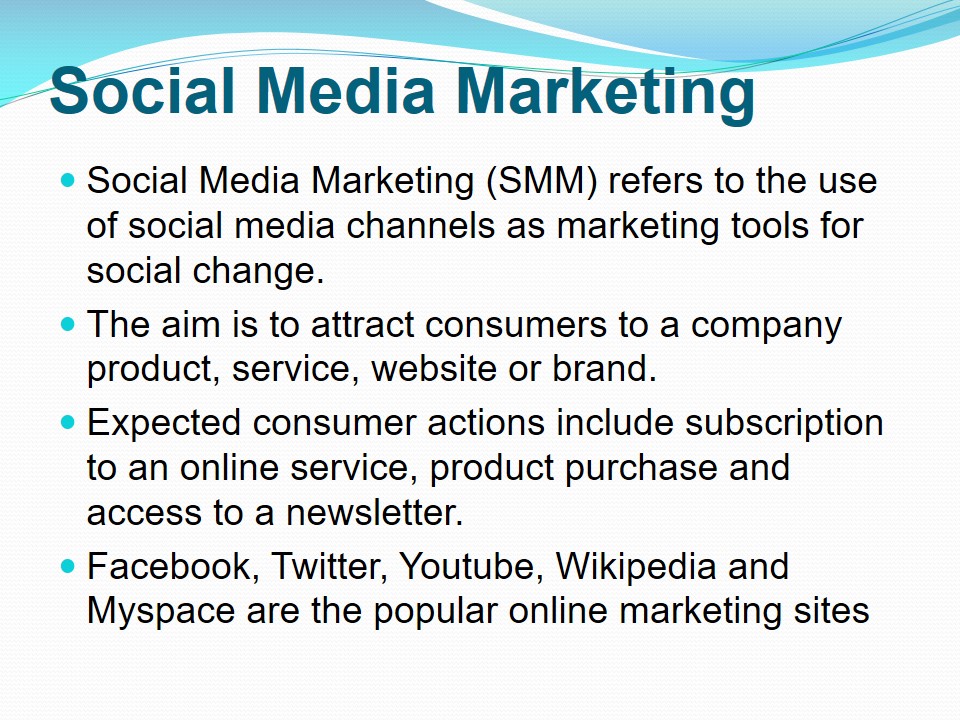
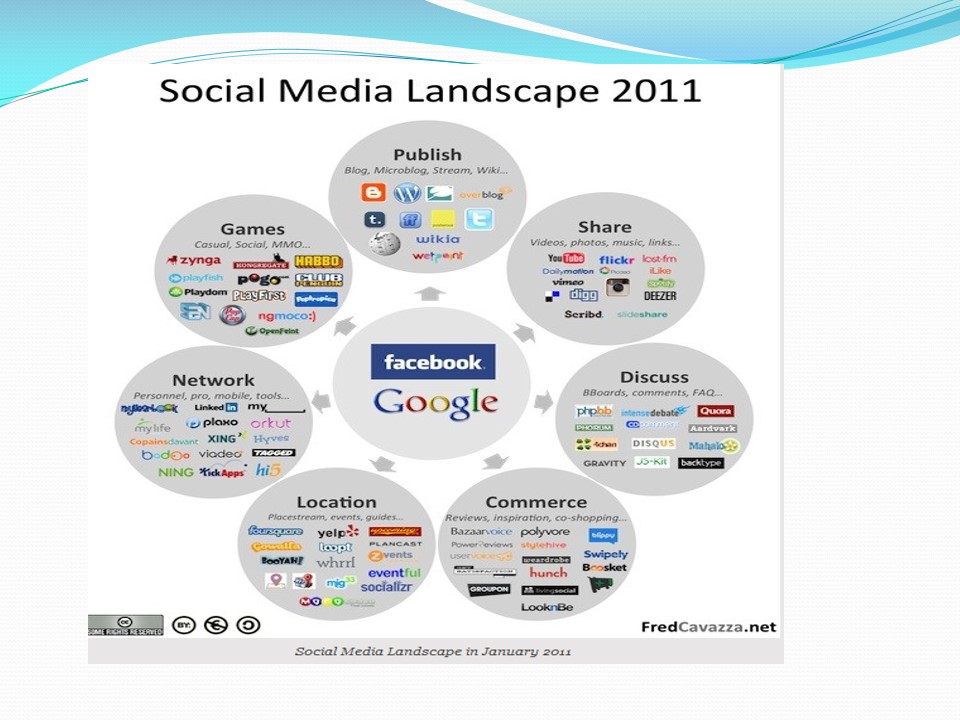
Marketing Through Social Media
- People use social media platforms to:
- Share, discuss, network/connect, play games.
- SMM differs from traditional marketing approaches in:
- Interactivity/accessibility;
- Addressability;
- Connectivity;
- Control.
- Importance of social media presence:
- Brand promotion;
- Customer Relations Management (CRM);
- Enhancing investor confidence;
- Sales growth;
- Reduce marketing costs.
Social media enables marketers to build fruitful customer relationships, expand to new markets previously unreached by the traditional media channels, and offer content that is market-specific. Effective SMM involves use of multiple social media channels to interact with the customers. Furthermore, SMM has the potential of giving a company a competitive edge over its rivals.
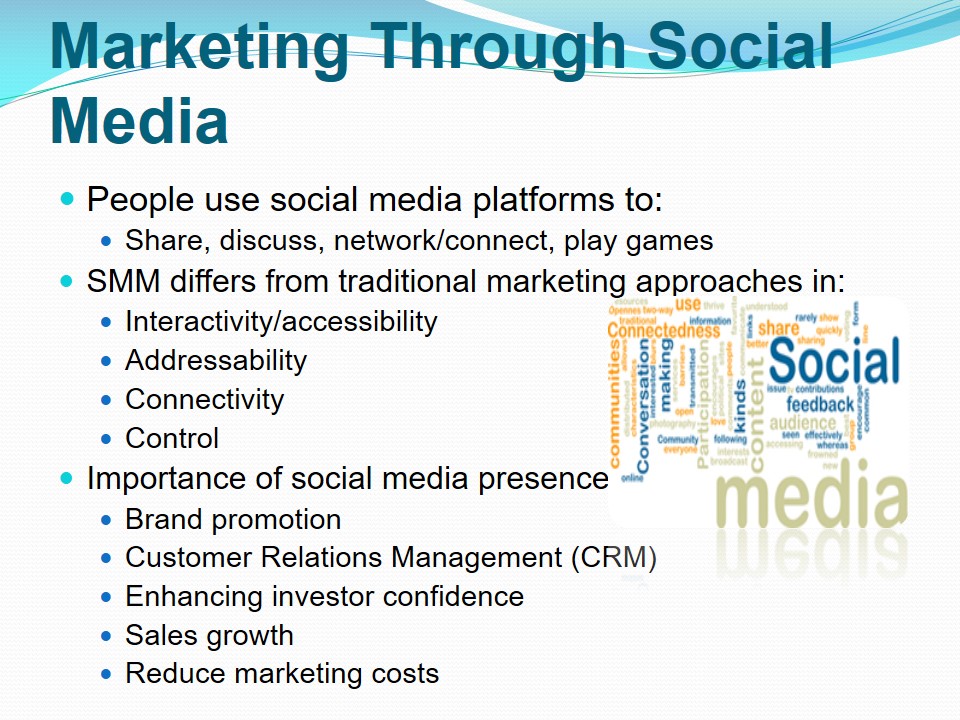
Advantages of SMM
Pros
- It helps businesses to:
- Expand to new markets/increase global presence.
- Build reputation through user-ratings.
- Develop relevant content for a target market.
- Increase brand awareness/customer royalty.
- Cut marketing costs and increase profit.
- Share information between:
- Marketers.
- Customers.
- Suppliers.
One important benefit of social media marketing is that it facilitates sharing of information and interaction between the consumers and the company marketing team as well as interaction between the company management and the suppliers (Martinez, 2011). It also helps marketers enhance brand awareness and build the company reputation.
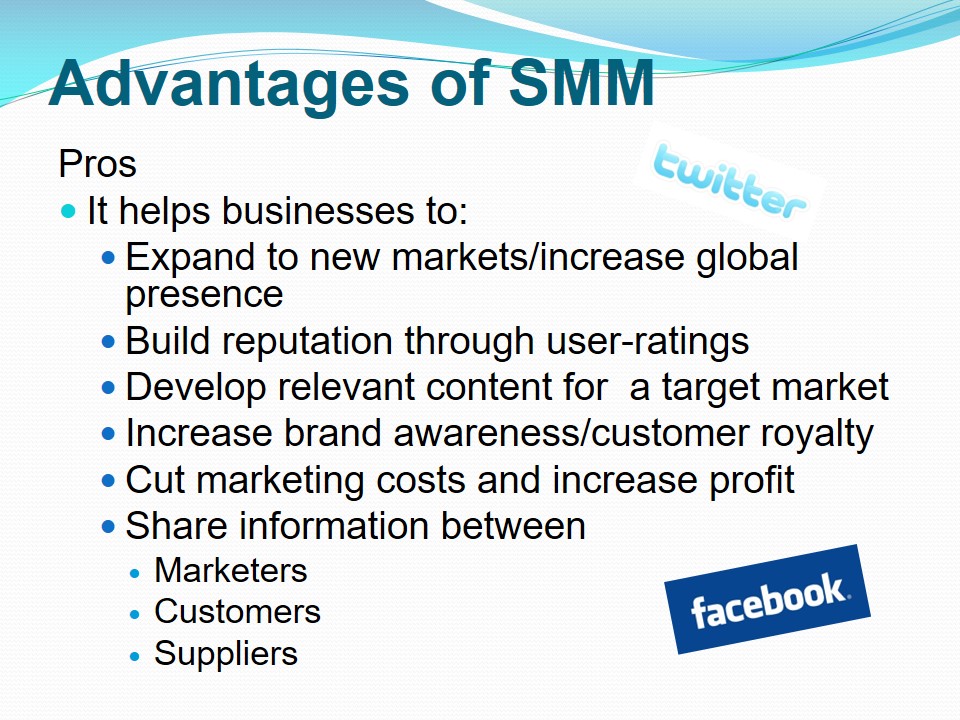
Disadvantages of SMM
Cons
- Limited control of content posted.
- Not many people read online ads.
- A low customer rating will affect sales.
- Privacy issues/leaking confidential information.
- Difficult to determine ROI.
- Ads may not reach the target market.
- Posting content/review of customer comments is time-consuming.
SMM poses many challenges to the company. The firm risks losing control of the content posted on social media channels, which gives room for negative publicity. Another disadvantage is the fact that not many people take social media adverts seriously. Thus, the intended audience may not use this information. Low customer ratings can also adversely affect the reputation of the company. The increase in the number of SMM sites, the inability to calculate the return on investment (ROI) and the inappropriate timing of ads are also some of the challenges of SMM.
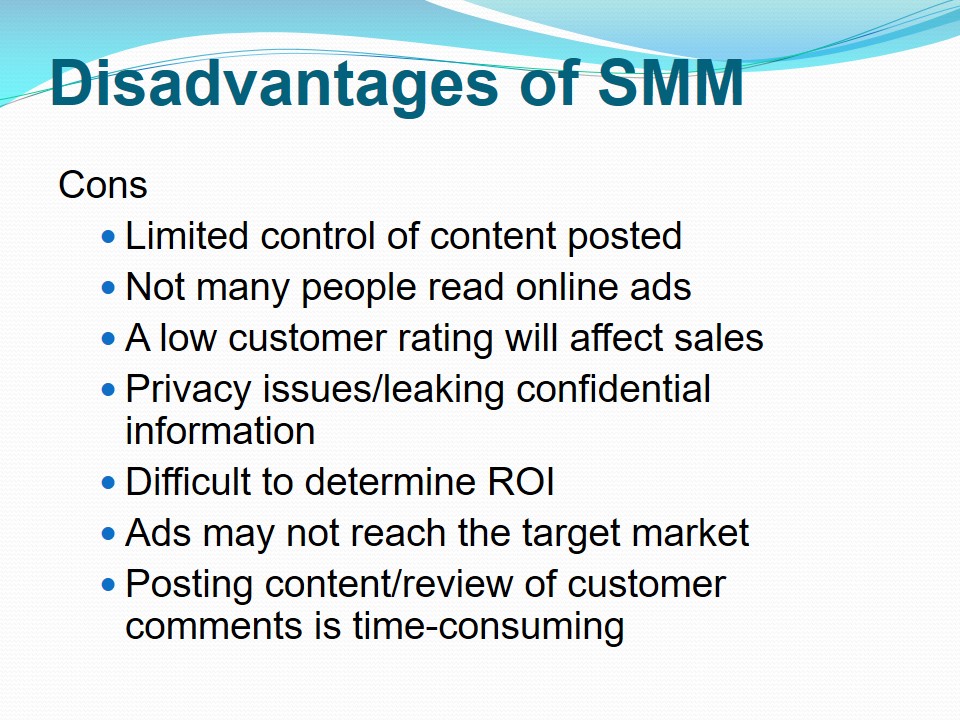
Trends in SMM
- Consumers post/publish product reviews, comments and opinions on SMM channels.
- Thus, more interactive than traditional media.
- SMM involves customer reference:
- Purchase depends on recommendations from friends or family;
- Consumers depend on other customers’ product reviews.
- Social media consumer behaviors:
- Easy access to product information;
- Sharing/interaction with one another;
- Comparing of new offers/deals.
- Marketers can capitalize on consumer SMM use trends to develop appropriate marketing mixes.
Consumers often use social media platforms to share their views, thoughts and perceptions regarding a particular company product or service. Thus, social media are more interactive compared to the other marketing approaches. Also, consumers often use the other customers’ reviews in their purchase decisions. They depend on recommendations from other consumers when buying a product for the first time.
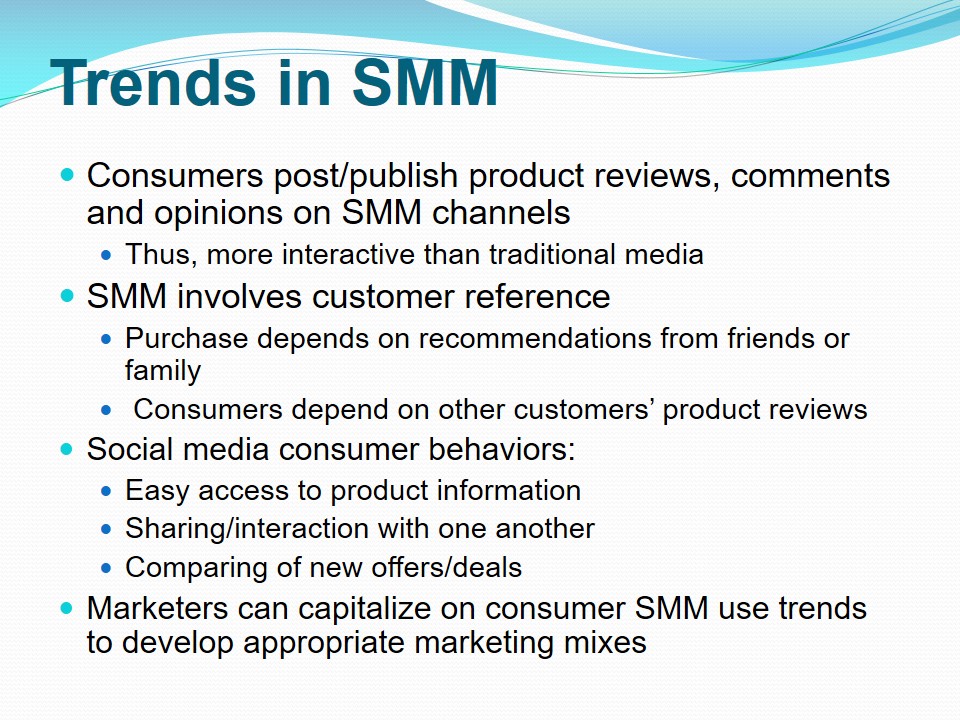
The “Pepsi Refresh Project”
- PepsiCo launched its SMM project in early 2008.
- Consumers rate Pepsi “brands on the Pepsi Refresh Website” (PepsiCo, 2011, Para. 2).
- Cross-channel marketing offers a platform for customers to interact with PepsiCo:
- Consumers post their ideas;
- Consumers rate these ideas; a contest;
- Pepsi funds the best ideas/initiatives; this leads to positive results;
- Consumers/users rewarded or recognized.
- Consumers post their ideas.
- Visitors vote for the best idea.
- The best idea gets funded.
- Recognition for great initiatives.
PepsiCo’s project used social media as a platform for SMM. The customers were given a chance to post their ideas and rate them, just like in a competition. Pepsi funded the best idea and rewarded the user(s) who gave the idea (PepsiCo, 2011). This project had implications on PepsiCo’s corporate social responsibility as well as on its performance. Increase in the number of users visiting its website, improvement in consumer perception and increase in sales are some of the benefits PepsiCo gained from this project.
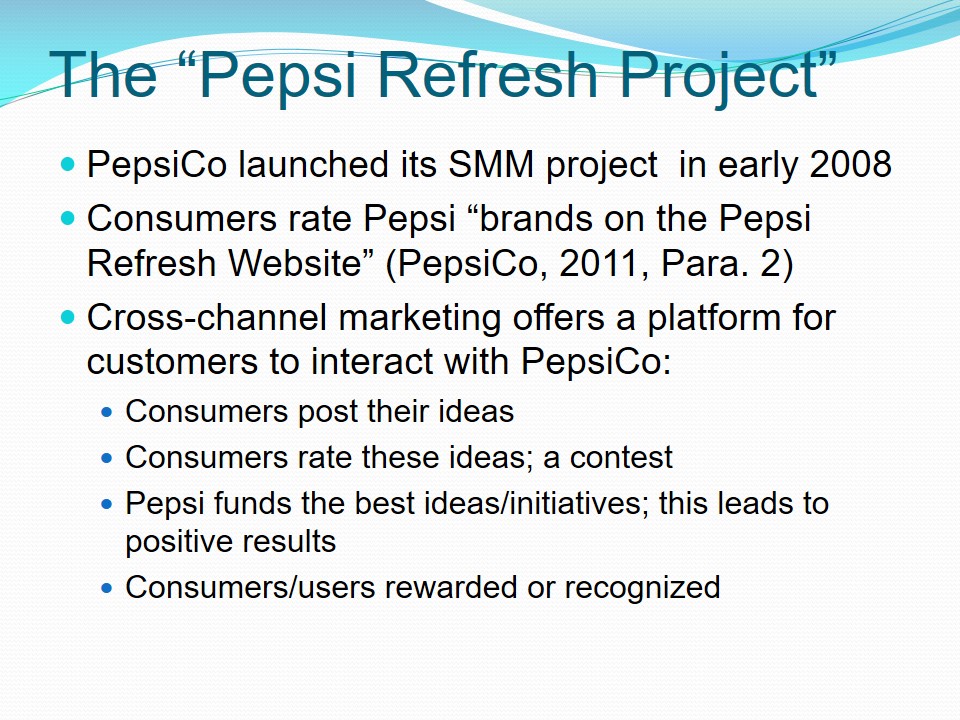
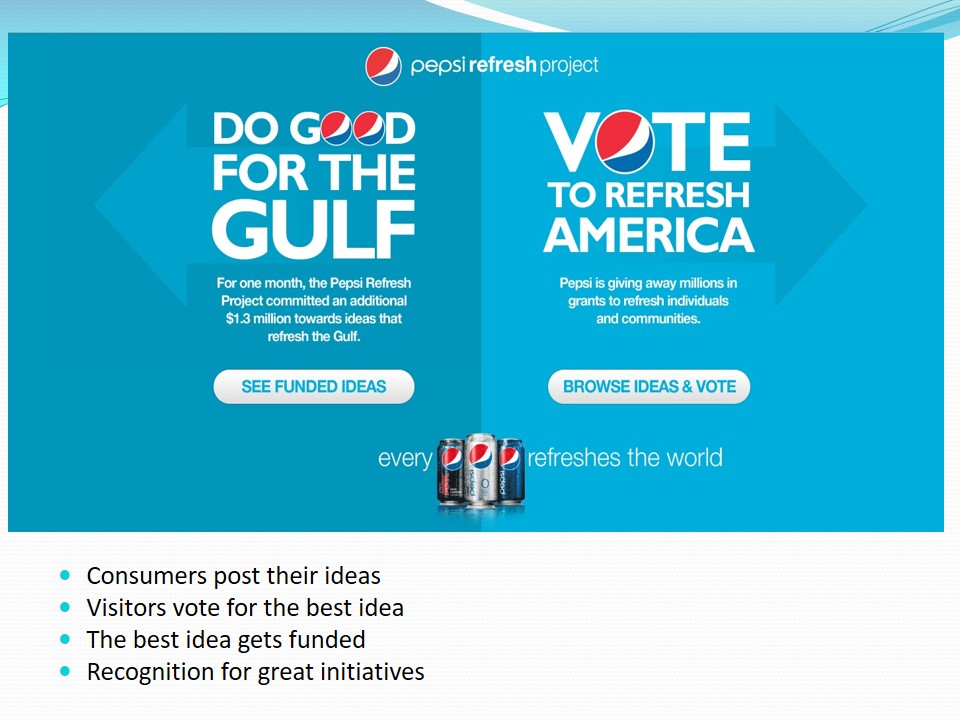
Impacts of the Pepsi Project
- Impact on corporate social responsibility (CSR):
- Has funded over 676 public initiatives;
- It has helped fund CBOs/public initiatives in the United States;
- This amounts to $21,350,000 to date (PepsiCo, 2011);
- Improvement in the company’s public image.
- Impact on PepsiCo brand:
- Increased traffic on its website; 82 million visited the website in 2011 with over 89,000 comments posted(PepsiCo, 2011);
- 60,000 twitter followers and over 3 million Facebook users (PepsiCo, 2011).
- No immediate impact on sales numbers:
- In 2010, sales fell by about 10% (Stelzner, 2010);
- Rise in intent to purchase Pepsi brand;
- Long-term consumer royalty and positive perception of Pepsi.
- Gains:
- Improved customer perception;
- Enhanced customer royalty;
- Increased brand recognition;
- Reduction in marketing costs.
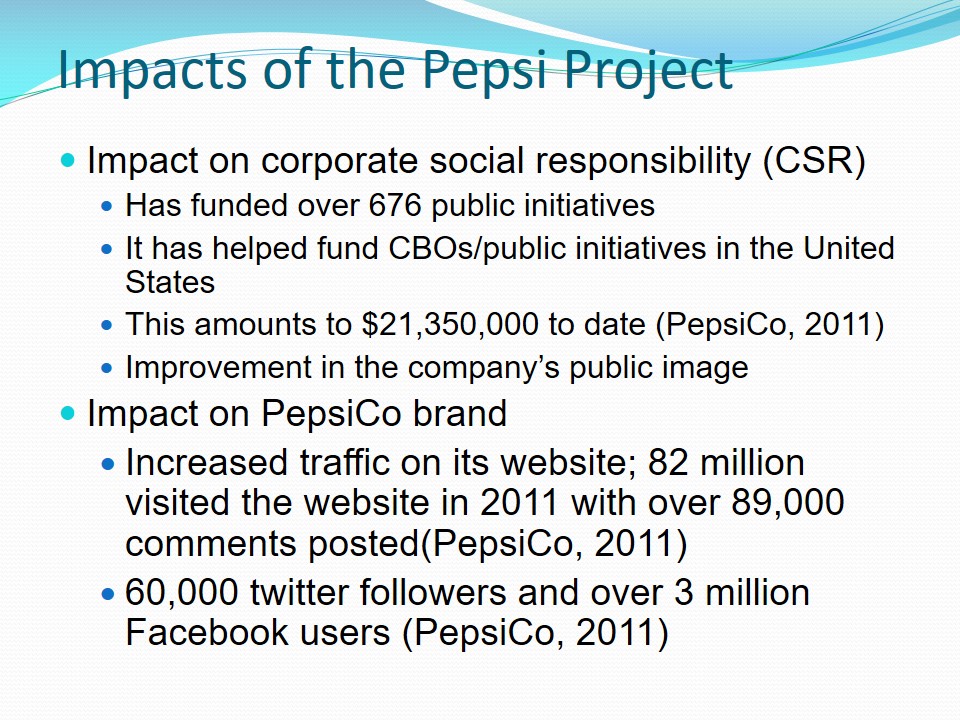
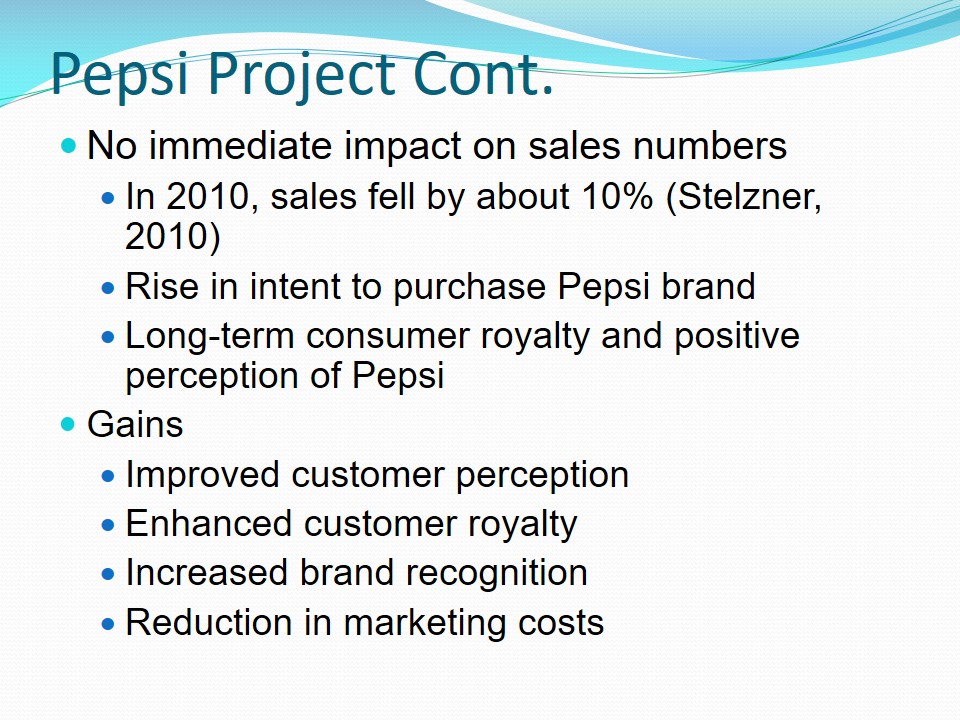
Other Case studies
- Ford’s Fiesta Movement:
- Launched in 2009;
- Involves bloggers to post comments and upload videos on YouTube;
- Very successful; 6.5 million people viewed the videos, 3.5 million followers on twitter and Flickr (McCracken, 2010).
- Bob Evans Restaurants SMM strategy:
- Involved giving free “potato fries” on National days;
- Generated 6 million impressions on social media;
- It generated an ROI of over 200% (Stelzner, 2010).
Several organizations have integrated SMM into their marketing strategies. Bob Evans, one of the leading food companies, has successfully implemented SMM to market its over 600 restaurants located in different states. Its “potato fries” online campaign generated over 6 million impressions on social media with over 40,000 “likes” on its Facebook page (Stelzner, 2010). Its ROI also rose significantly in 2010. Another company that has successfully adopted SMM is Ford through its Fiesta movement. The campaign aims to promote its automobiles by getting bloggers to comment about its products (crowd sourcing).
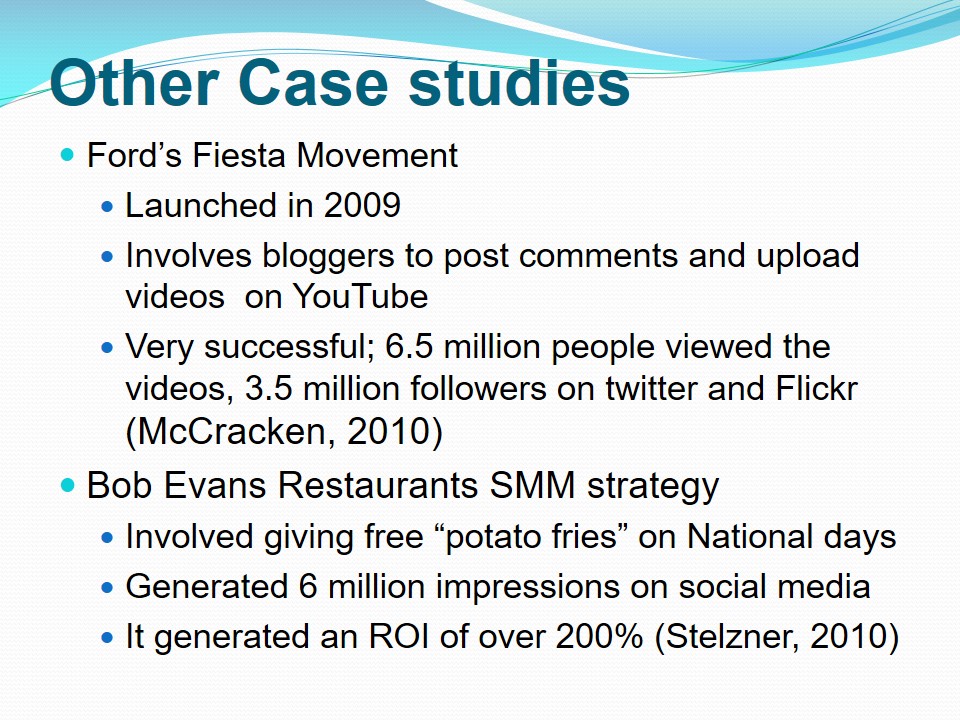
Implications of SM on Businesses
- Implications:
- Crowd sourcing can be achieved through social media;
- Social media integration develops a consumer community;
- Social Media shape consumer perceptions;
- Cross-channel marketing is important for CRM;
- Marketing cost reduction; improvement in CSR
- Skills to improve in SMM:
- Technical skills:
- Computer skills; graphic design; internet use/navigation.
- Personal skills:
- Listening and comprehension; creativity; professionalism when handling customer responses.
- Technical skills:
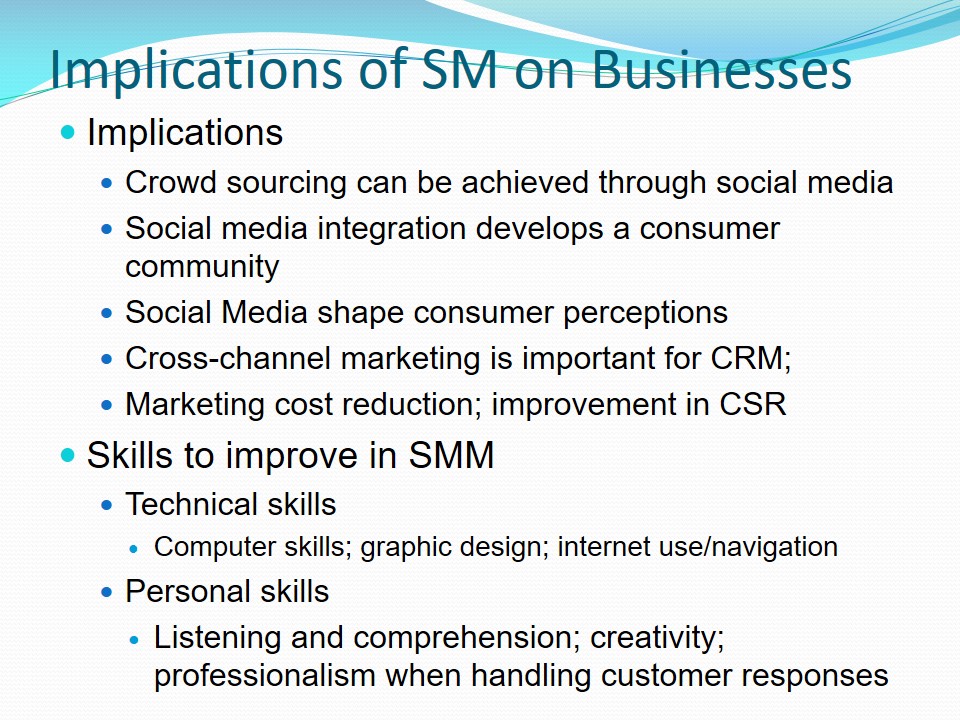
References
Groeger, L. (2011). For ‘creativity,’ just add ‘crowd’. Web.
Martinez, J. (2011). Every channel has its thorns. Customer Relationship Management, 15(1), 16-19.
McCracken, G. (2010). How Ford got Social Marketing. Web.
PepsiCo. (2011). Pepsi Refresh Project. Web.
Stelzner, M. (2010). Social Media Marketing Industry Report. Web.